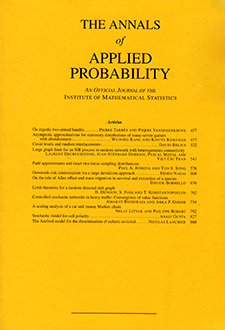Abstract
Based on a new coupling approach, we prove that the transition step of the Hamiltonian Monte Carlo algorithm is contractive w.r.t. a carefully designed Kantorovich ($L^{1}$ Wasserstein) distance. The lower bound for the contraction rate is explicit. Global convexity of the potential is not required, and thus multimodal target distributions are included. Explicit quantitative bounds for the number of steps required to approximate the stationary distribution up to a given error $\epsilon $ are a direct consequence of contractivity. These bounds show that HMC can overcome diffusive behavior if the duration of the Hamiltonian dynamics is adjusted appropriately.
Citation
Nawaf Bou-Rabee. Andreas Eberle. Raphael Zimmer. "Coupling and convergence for Hamiltonian Monte Carlo." Ann. Appl. Probab. 30 (3) 1209 - 1250, June 2020. https://doi.org/10.1214/19-AAP1528
Information





